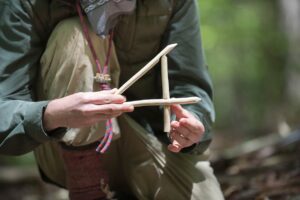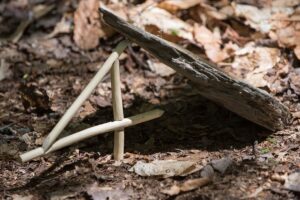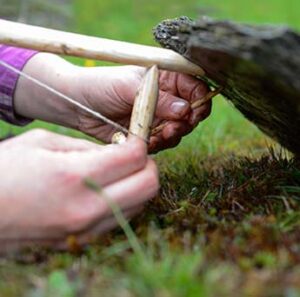 Outdoor living skills, such as learning how to make traps, are an integral part of the wilderness therapy experience at True North. Our students learn how to make two types of traps, the Paiute Deadfall and the Figure Four. They make a total of four traps and learn how to set them up with flat rocks they find near their campsites. Each trap comes with its own unique set of mechanical challenges, from harvesting trees and selecting straight, uniform pieces of wood, to using tools to shape those pieces of wood so they fit together like a puzzle. The functional purpose of making traps often feels less clear than some of the other outdoor living tasks our students engage in, such as making fire to cook dinner or learning to tie knots that hold up a sleep shelter. We don’t bait traps either, so we aren’t relying on them for food (as was their function in early American history). The purpose of making traps may be less obvious, yet, from an experiential learning standpoint, it has enormous value.
Outdoor living skills, such as learning how to make traps, are an integral part of the wilderness therapy experience at True North. Our students learn how to make two types of traps, the Paiute Deadfall and the Figure Four. They make a total of four traps and learn how to set them up with flat rocks they find near their campsites. Each trap comes with its own unique set of mechanical challenges, from harvesting trees and selecting straight, uniform pieces of wood, to using tools to shape those pieces of wood so they fit together like a puzzle. The functional purpose of making traps often feels less clear than some of the other outdoor living tasks our students engage in, such as making fire to cook dinner or learning to tie knots that hold up a sleep shelter. We don’t bait traps either, so we aren’t relying on them for food (as was their function in early American history). The purpose of making traps may be less obvious, yet, from an experiential learning standpoint, it has enormous value.

True North students make traps during the second phase of the program. This is the same point at which they create an individualized personal development goal. Just as each student’s goal is unique to their personal values and challenges, so is their experience building traps. This experience might mean learning how to ask for help, facing a fear of failure, exploring strategies for managing personal expectations, or developing skills for personal motivation. Our clinical team regularly discusses the experience of making traps with our students. We focus on the process rather than the outcome. Our aim is to help students build an understanding of what it took to get to the finish line. When they succeed we say, “great, what did you learn?” When they fail we say, “great, what did you learn?”

The purpose of traps is that they are an experience, a process, and a tool. By building traps our students learn about themselves. They may recognize just how often they compare themselves to others, are more capable than they give themselves credit for, or act carelessly, resulting in more work in the long run. For every student the process looks different, however, the end result is always the same – four well-made, completed traps and an experience of personal understanding and growth.


